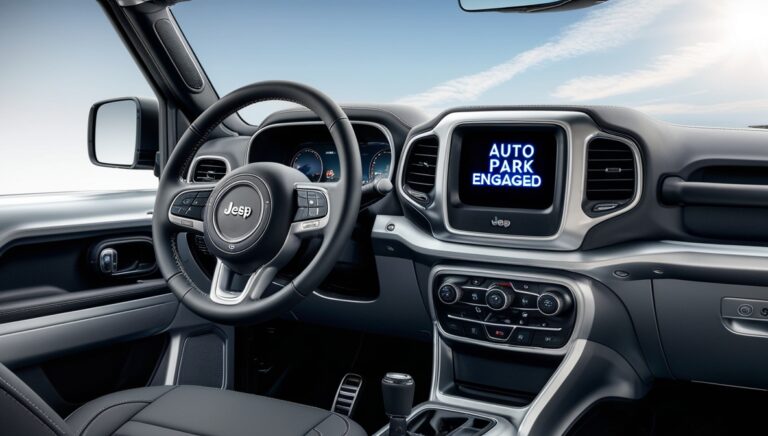Why Is My Gas Cap Light On Jeep Wrangler? Common causes and solutions!
Have you ever been puzzled by the gas cap light illuminating on your Jeep Wrangler? It’s a common issue that can be caused by various factors. Understanding why this light comes on and how to address it can save you time, money, and frustration.
In brief, when gas cap light comes on, it means that your evaporative emissions system is leaking somewhere, causing a loss of pressure in the system. The problem is most likely for the loose gas cap, clogged or old gas cap. If that’s not the case, then there could be another component causing the leak.
However, to get a comprehensive detail about the problem, go through to our today’s guide till the end.
Key Takeaways:
- Ensure your gas cap is securely tightened to prevent triggering the gas cap light on your Jeep Wrangler.
- Regularly inspect and maintain your vehicle’s fuel system components to avoid potential issues and maintain proper emissions control.
- Promptly address any persistent gas cap light warnings by diagnosing and resolving underlying fuel system issues with professional assistance.
Reasons And Easy Fixes For Gas Cap Light On Jeep Wrangler
The gas cap light on your Jeep Wrangler is like a warning sign for a small leak in the evaporative system.
This leak allows gasoline to evaporate into the air because the system can’t hold pressure properly.
Usually, the main problem causing this is with the gas cap. Here’s what could be wrong with it:
1# Loose Gas Cap
A loose gas cap can allow air to enter the fuel system, disrupting the pressure levels. When the pressure isn’t maintained within the specified range, your vehicle’s onboard diagnostic system detects it and triggers the gas cap light to alert you of a potential issue.
Fix:
Here’s how you can address a loose gas cap:
- Start by visually inspecting the gas cap. Ensure it’s not visibly damaged or missing any parts.
- Twist the gas cap clockwise until you hear a clicking sound. This indicates that the cap is securely closed and properly sealed.
- After tightening the gas cap, start your Jeep Wrangler and drive it for a short distance. If the gas cap light stays off, it likely means that tightening the cap resolved the issue.
- Ensure it’s always securely closed to prevent future occurrences of the gas cap light turning on.
2# Clogged Gas Cap
A clogged gas cap presents a common culprit behind the gas cap light illuminating on your Jeep Wrangler.
Debris accumulation, including dirt or ice, can obstruct the seal or vent holes of the gas cap, disrupting its ability to maintain a proper seal and ventilation.
When these vital components become blocked, pressure irregularities arise within the fuel system.
Additionally, buildup around the seal compromises its effectiveness, leading to air or fuel vapor leaks. These issues collectively trigger the gas cap light.
Fix:
Follow the below steps to fix the problem.
- Step 1: Examine the gas cap for any visible signs of debris or dirt accumulation. Pay close attention to the seal and vent holes.
- Step 2: If you notice debris on the gas cap, carefully clean it using a cloth and mild detergent. Ensure thorough cleaning around the seal and vent holes to restore proper functionality.
- Step 3: Check the vent holes for blockages and clear them using a small tool or compressed air. Be gentle to avoid damaging the gas cap.
3# Old Gas Cap
An old gas cap can be a culprit behind the gas cap light appearing on your Jeep Wrangler.
Over time, the seal on the gas cap deteriorates, becoming less effective in maintaining a tight seal.
Additionally, the materials of the cap may become brittle, leading to cracks or damage that compromise its integrity.
Continuous use and exposure to elements contribute to wear and tear, diminishing the cap’s ability to create a proper seal.
These factors collectively result in pressure fluctuations within the fuel system, triggering the gas cap light.
Fix:
Inspect the gas cap for signs of wear, such as cracks, brittleness, or deterioration of the seal.
Pay attention to any visible damage that may compromise its effectiveness. If the gas cap shows signs of aging or damage, it’s advisable to replace it with a new one.
Choose a replacement gas cap that is compatible with your Jeep Wrangler model and ensures a secure and tight seal.
Other Possible Reasons
If the gas cap isn’t the issue, there might be a leak in your Jeep Wrangler’s fuel system.
First, check and replace the gas cap if necessary. If that doesn’t fix it, you’ll need to test for leaks in the EVAP system components.
4# Problem With The EVAP Canister
The gas cap light on your Jeep Wrangler often indicates a small fuel system leak, typically caused by problems with the EVAP canister.
If this component malfunctions, fuel vapors may escape, triggering the light. Issues with the LDP or EVAP system connections can also contribute.
Timely repairs are essential to maintain emissions control and prevent performance issues.
Fix:
Follow out the below steps to fix the issues.
- Step 1: Have your Jeep Wrangler diagnosed by a qualified mechanic to pinpoint the issue accurately.
- Step 2: Depending on the problem identified, repair or replace faulty components such as the EVAP canister, leak detection pump (LDP), hoses, or valves.
- Step 3: After repairs or replacements, conduct tests to ensure the integrity and proper functioning of the EVAP system. This may involve a smoke test or diagnostic equipment to verify no leaks are present.
5# Leak In The Exhaust System
An exhaust system leak can trigger the gas cap light on your Jeep Wrangler due to:
- Damaged Components: Exhaust pipes, mufflers, or gaskets can deteriorate over time, leading to gaps where unburned fuel vapors can escape.
- Rust or Wear: Exposure to moisture, road salt, and heat can cause rust and weaken the exhaust system’s components, creating opportunities for leaks.
- Improper Installation: Poorly installed exhaust components or loose fittings can result in gaps that allow exhaust gases to escape.
Fix:
Here is how you can fix it.
- Look for signs of damage, corrosion, or gaps in the exhaust system components, including pipes, mufflers, and gaskets.
- Depending on the extent of the damage, you may need to repair or replace the affected components. Welding may be necessary for minor repairs, while severe damage may require component replacement.
- Use exhaust sealant or high-temperature-resistant tape to seal small leaks temporarily until proper repairs can be made.
- If you’re unsure about the extent of the damage or how to proceed with repairs, consult a qualified mechanic for a thorough inspection and professional repairs.
6# Failed Fuel Pump Seal
Over time, the seal around the fuel pump assembly can degrade, allowing fuel vapors to escape.
This can occur due to factors such as exposure to heat, fuel additives, or mechanical wear.
Moreover, a compromised fuel pump seal can disrupt the pressure balance within the fuel system, leading to fluctuations that trigger the gas cap light.
Fix:
Addressing a failed fuel pump seal is essential for maintaining the integrity of your vehicle’s fuel system and emissions control.
Have your Jeep Wrangler inspected by a qualified mechanic to determine if the fuel pump seal is the source of the issue.
If the fuel pump seal is found to be faulty, it may need to be replaced. This typically involves removing the fuel pump assembly from the fuel tank and installing a new seal.
Due to the complexity of working with fuel system components, it’s advisable to have a trained professional perform the repair to ensure it’s done correctly and safely.
Estimated Cost For Replacing The Faulty Parts
Here is the estimated cost for possible faulty parts behind the gas cap light on Jeep Wrangler. You can check it out for a rough estimation.
[Note: The estimated costs provided for replacing faulty parts in your Jeep Wrangler’s are approximate and may vary based on factors such as your location, vehicle model, and labor charges.]
| Possible Faulty Parts | Estimated Cost |
| Gas Cap | $10 to $106 |
| EVAP canister | $253 and $290 |
| Fuel pump seal | $20 and $30 |
Gas Cap Light After Replacing The Gas Cap: How To Fix It!
If the gas cap light persists after replacing it on your Jeep Wrangler, there could be various reasons behind it:
1# Check The Fuse:
A blown fuse can also cause the gas cap light to remain on. Inspect the fuse related to the gas cap light in the vehicle’s fuse box and replace it if necessary.
2# Tighten Gas Cap:
Even with a new gas cap, it’s essential to ensure it is securely tightened. Sometimes, a slightly loose cap can still trigger the light. Double-check the gas cap to ensure it is properly tightened.
3# Check The Installation Of The Gas Cap:
If the gas cap isn’t installed correctly or is loose, it won’t create a proper seal, leading to the gas cap light staying on.
4# Reset the Warning:
Try resetting the gas cap warning light. You can do this by
- Removing the “NEG” cable from the battery for at least 15 minutes.
- Alternatively, driving the vehicle for 50-75 miles of combined city and highway driving can also prompt the onboard computer to recognize the issue is fixed and clear the light.
5# Check The Gas Cap:
Even a small crack in the gas cap can prevent it from sealing properly, causing the gas cap light to illuminate again. Inspect the gas cap for any cracks or damage and replace it if necessary.
FAQs
Here are the answers of some queries that are mostly asked by the jeep wrangler owners about the gas cap. Check it out to know more.
Why does it say gas cap even if my gas cap is on?
The gas cap light may illuminate even with the gas cap on due to issues like a loose or faulty gas cap, a clogged vent, or problems with the evaporative emissions system. These issues can disrupt pressure levels, triggering the warning light.
Is it OK to drive with a gas cap light on?
Yes, it’s generally safe to drive with the gas cap light on, but it’s essential to address the underlying issue promptly. Ignoring it could lead to reduced fuel efficiency and potential damage to the vehicle’s emissions control system.
What symptoms does a bad gas cap cause?
A bad gas cap can cause various symptoms, including the illumination of the gas cap light on your dashboard, decreased fuel efficiency, an unusual smell of gasoline around the vehicle, and potential difficulty starting the engine.


